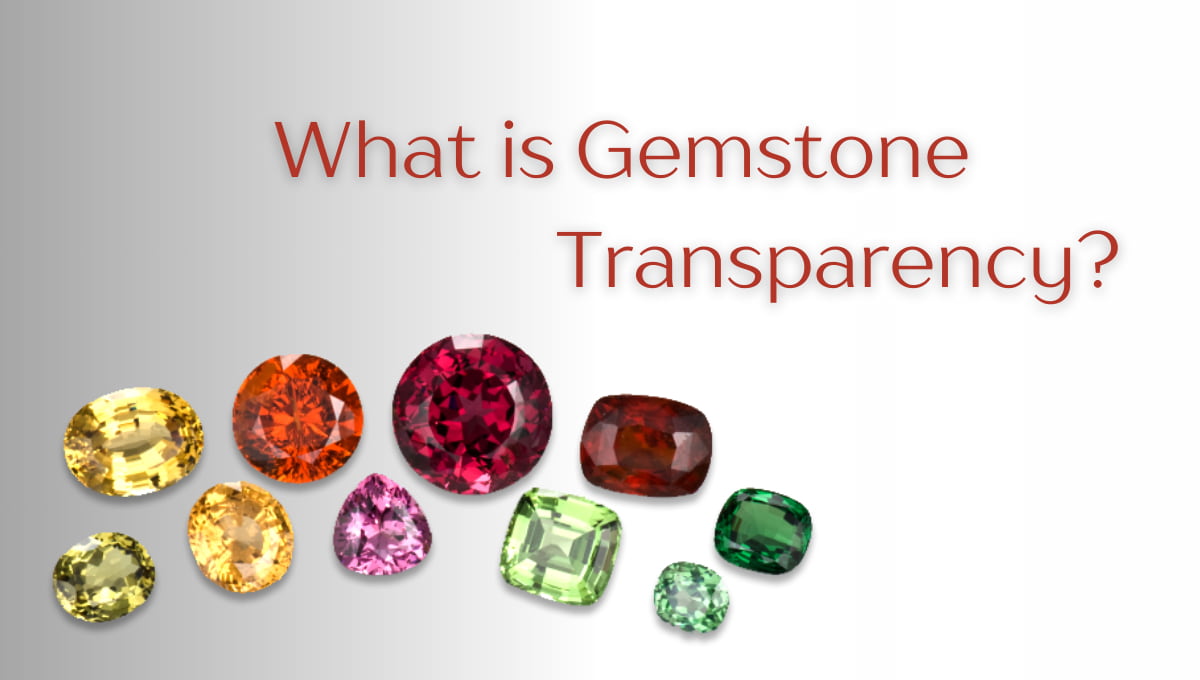The value or worth of a gemstone is defined by a plethora of pre-defined characteristics and transparency is one of them. A gemstone’s transparency refers to the extent a light can pass through a gemstone. Gemstones transparency can showcase varied ranges starting from transparent to semi-opaque and opaque. The more a gemstone is transparent, the more gemstone allows light to pass through it and exhibit brilliance.
Gemstones with astounding levels of transparency often exhibit par excellent level of refraction and reflection which results in a scintillating display of colors. Some of the finest examples are yellow sapphires, natural ruby stones, diamonds, alexandrite, etc. To know the concept of gemstone transparency in depth, we have created this all-inclusive blog post that covers all the ins and outs of transparency in gemstones and how it impacts the overall value.
What is Gemstone Transparency?
At the subatomic realm, gemstones possess an intrinsic ability to selectively interact with the electromagnetic spectrum, exhibiting unique behaviors of absorption, transmission, and reflection across various wavelengths of light. The specific wavelengths of visible light that a particular gemstone permits to pass through its crystalline structure are what our eyes perceive as the gem’s distinctive hue.
Gemstone transparency is a qualitative measure that encapsulates the degree to which a gem can facilitate the passage of light through its internal lattice, as well as the extent to which the transmitted light is dispersed or scattered upon exiting the gemstone. This characteristic is a manifestation of the gem’s atomic composition, crystal structure, and the presence or absence of inclusions or impurities within its molecular arrangement.
Must Check: – Most Sparkling Gemstones
Highly transparent gemstones, such as diamonds or certain varieties of corundum, allow a substantial portion of incident light to traverse their crystalline matrix with minimal scattering, resulting in a brilliant and lustrous appearance. Conversely, opaque gemstones, like turquoise or jade, absorb or reflect most of the incoming light, preventing significant transmission and exhibiting a more muted or subdued visual presence.
Between these two extremes lies a spectrum of translucency, where gemstones exhibit varying degrees of light transmission and scattering. Semi-transparent gems, like amethyst or citrine, permit a portion of light to pass through while simultaneously diffusing or refracting it, creating a distinctive depth and vibrancy in their appearance.
The interplay between a gemstone’s atomic structure, chemical composition, and the intricate dance of light waves within its crystalline lattice gives rise to the captivating kaleidoscope of colors and optical properties that have mesmerized humankind throughout history.
Don’t Miss: – Can We Wear Gemstones Once Removed
Different Levels of Transparency
Transparent
Transparent gemstones are prized for their ability to let light pass through with little obstruction, showcasing remarkable clarity and brilliance. Their high internal reflection and refraction result in stunning displays of color and sparkle. Notable examples of these radiant gems include diamond, ruby, ceylon blue sapphire, emerald gemstone, and aquamarine.
Translucent
You know those gemstones that don’t let all the light through, but still give off a nice subtle glow? Those are the translucent ones. They’re like a cozy reading nook on a rainy day – the light filters through, but it’s all soft and diffused. Sure, they might not blind you with brilliance like those totally transparent rocks, but translucent gems have their own vibe going on. The way the colors play and shift as the light moves through them is super chill. We’re talking moonstone, chalcedony, opal, jadeite – those dreamy, misty beauties. Not too in-your-face, but still stunning in their own laidback way.
Also Read: – Dispersion in Gemstones
Semi-Transparent
Semitransparent gemstones let a fair amount of light filter through, yet often retain a touch of opacity or cloudiness. This gives them a somewhat hazy or milky look, which can influence their clarity and brilliance. Examples of such gemstones include rose quartz, prehnite, and amber.
Opaque
Opaque gemstones are truly mesmerizing! Unlike their sparkling, transparent counterparts that allow light to pass through, these beauties exude a captivating, solid richness. Their vibrant colors and distinctive patterns or inclusions make them stand out in a unique way.
While they may not dazzle with brilliance like diamonds or sapphires, opaque gems like turquoise, lapis lazuli, malachite, and onyx have a striking presence all their own. They’re like little works of art, each one telling a story through its intriguing hues and visual textures.
The transparency of a gemstone is influenced by various factors, like its chemical makeup, crystal structure, and any little impurities or inclusions it might have. Gemologists and jewelers take a close look at transparency when grading gemstones, as it plays a role in determining their overall quality and value.
But with opaque gems, it’s not about transparency – it’s about embracing their bold, earthy beauty and the captivating depth they bring to any piece of jewelry or collection.
Can You Measure Gemstone Transparency?
While it’s possible to scientifically measure a material’s opacity—from perfect transparency to complete opacity—gemologists typically rely on everyday terms like opacity, translucence, and transparency when describing gemstones. Transparency levels can vary widely within a single gem species, so pinpointing a gemstone’s transparency isn’t always helpful for identification. Generally, precise measurements aren’t needed. Descriptions like “near opaque,” “semi-translucent,” and “almost transparent” are usually sufficient to convey the optical properties that matter most to people.
Check Out: – Gemstone Luster
